Project Contract Management: Procurement Strategies Analysis
VerifiedAdded on 2019/12/28
|13
|3875
|431
Project
AI Summary
This project report delves into the intricacies of project contract management, focusing on a federal government township construction project. It explores various procurement strategies, including conventional, turnkey, and concession methods, and their implications for project success. The report analyzes the roles of the owner, contractor, and sub-contractor within the project framework. It evaluates the ease of management, financial burdens, risks of failure, project costs, and timelines associated with each procurement strategy. Through this analysis, the report recommends the most suitable strategy for the township project. The project involves constructing a mixed-development township with housing, offices, infrastructure, and amenities, requiring substantial financial and human resources. The report evaluates the best procurement strategy to manage the project effectively. The report provides a comparative analysis of procurement methods, including conventional, turnkey, and concession contracts, assessing their suitability based on management ease, financial implications, risk profiles, and project costs. The report recommends the traditional method.
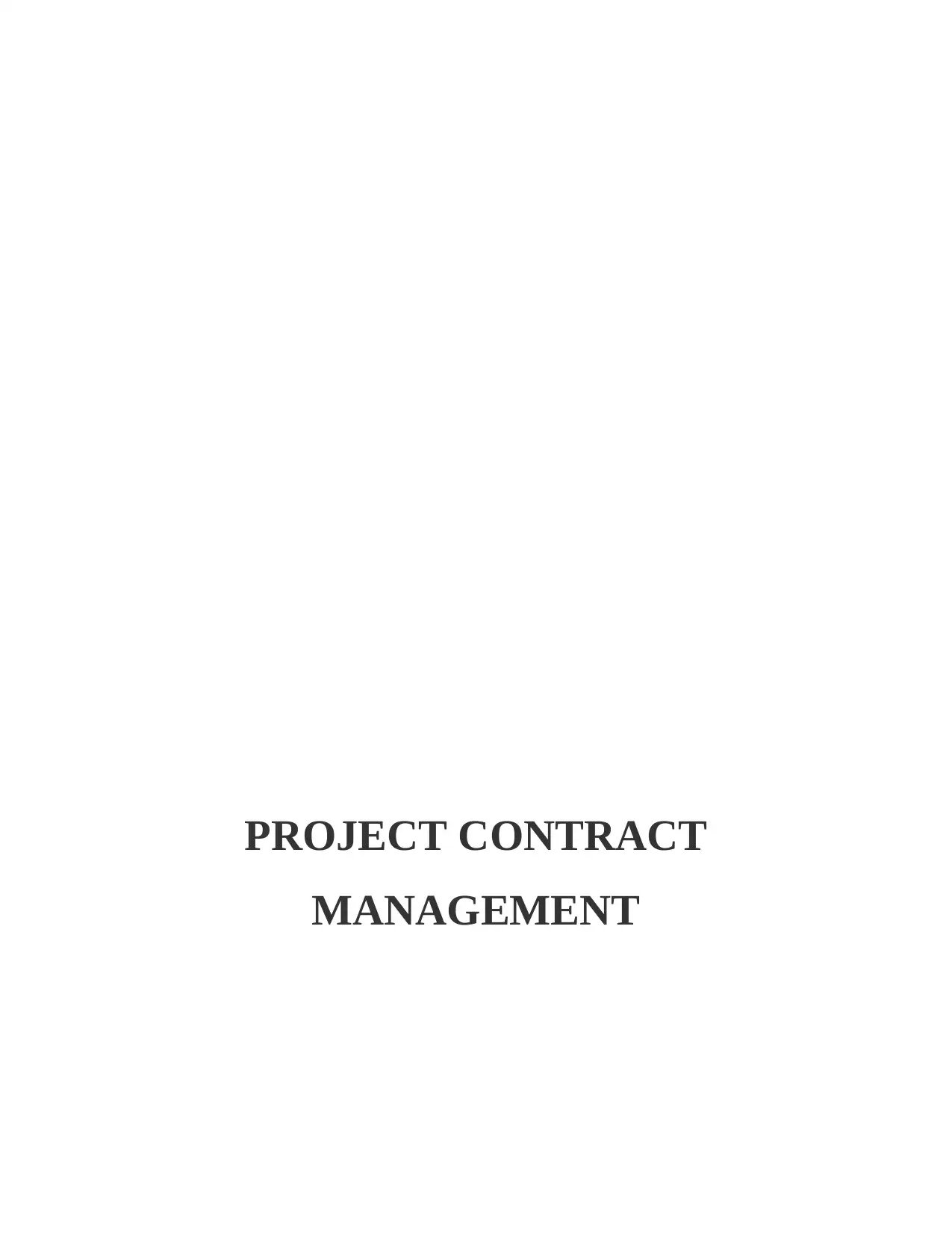
PROJECT CONTRACT
MANAGEMENT
MANAGEMENT
Paraphrase This Document
Need a fresh take? Get an instant paraphrase of this document with our AI Paraphraser
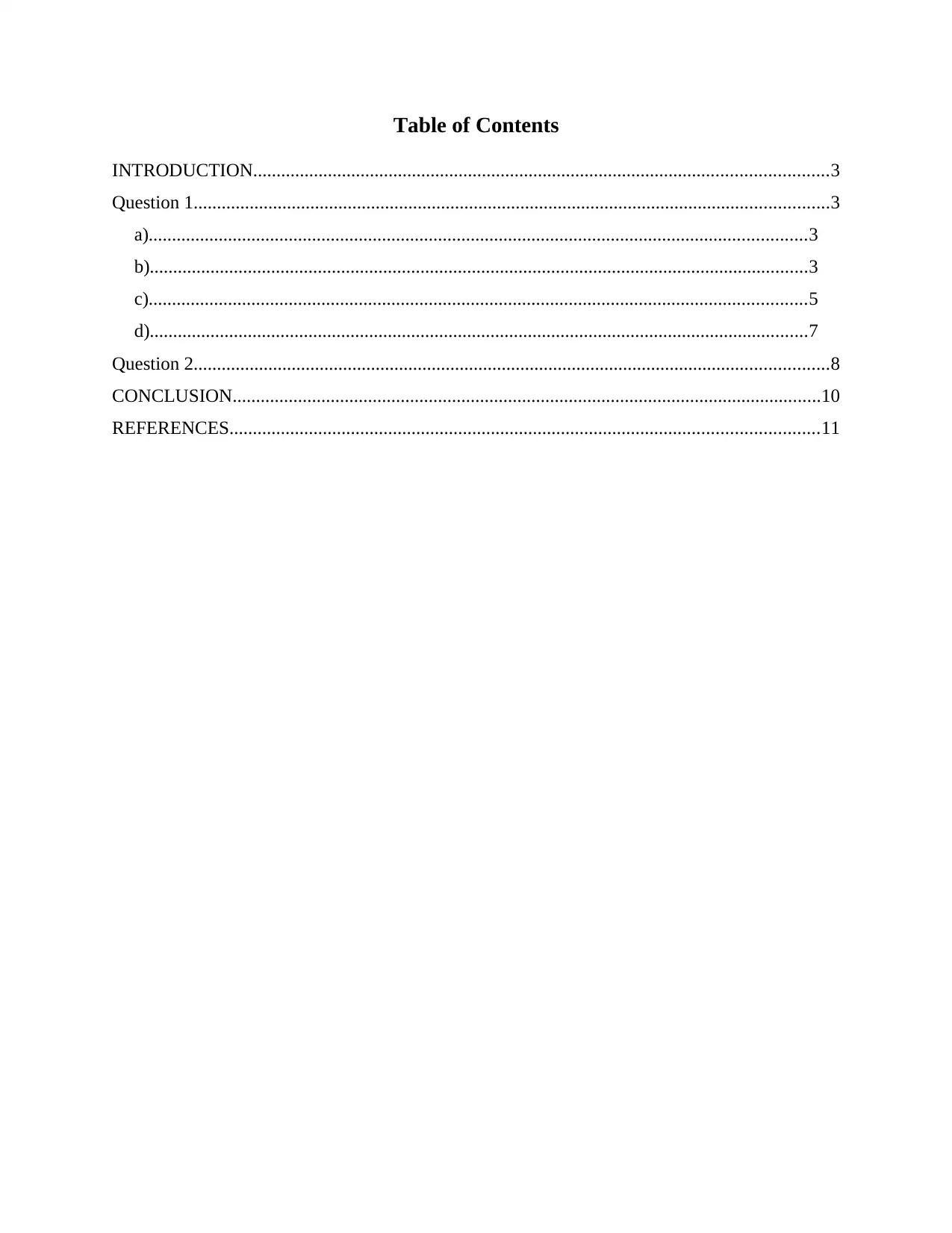
Table of Contents
INTRODUCTION...........................................................................................................................3
Question 1........................................................................................................................................3
a).............................................................................................................................................3
b).............................................................................................................................................3
c).............................................................................................................................................5
d).............................................................................................................................................7
Question 2........................................................................................................................................8
CONCLUSION..............................................................................................................................10
REFERENCES..............................................................................................................................11
INTRODUCTION...........................................................................................................................3
Question 1........................................................................................................................................3
a).............................................................................................................................................3
b).............................................................................................................................................3
c).............................................................................................................................................5
d).............................................................................................................................................7
Question 2........................................................................................................................................8
CONCLUSION..............................................................................................................................10
REFERENCES..............................................................................................................................11
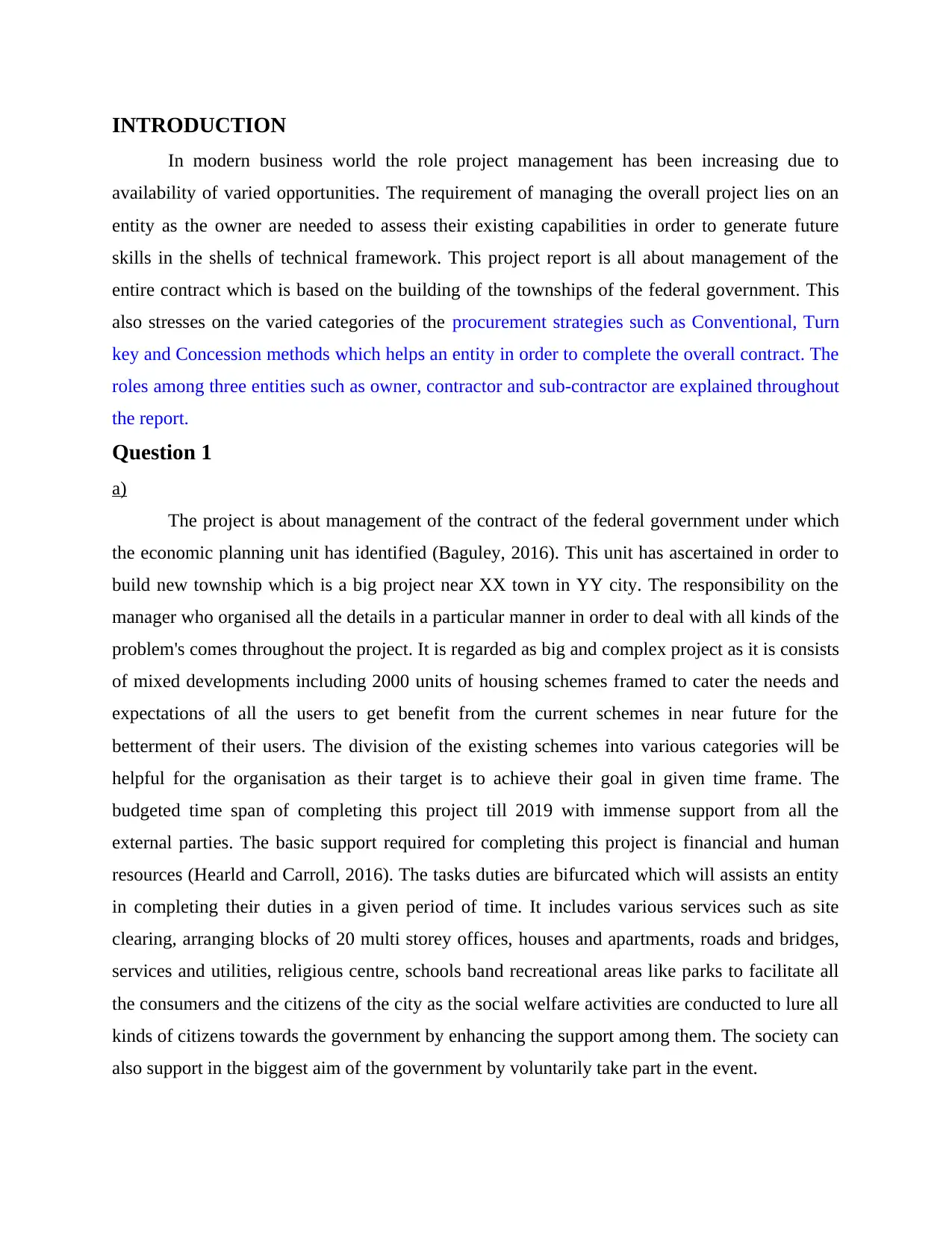
INTRODUCTION
In modern business world the role project management has been increasing due to
availability of varied opportunities. The requirement of managing the overall project lies on an
entity as the owner are needed to assess their existing capabilities in order to generate future
skills in the shells of technical framework. This project report is all about management of the
entire contract which is based on the building of the townships of the federal government. This
also stresses on the varied categories of the procurement strategies such as Conventional, Turn
key and Concession methods which helps an entity in order to complete the overall contract. The
roles among three entities such as owner, contractor and sub-contractor are explained throughout
the report.
Question 1
a)
The project is about management of the contract of the federal government under which
the economic planning unit has identified (Baguley, 2016). This unit has ascertained in order to
build new township which is a big project near XX town in YY city. The responsibility on the
manager who organised all the details in a particular manner in order to deal with all kinds of the
problem's comes throughout the project. It is regarded as big and complex project as it is consists
of mixed developments including 2000 units of housing schemes framed to cater the needs and
expectations of all the users to get benefit from the current schemes in near future for the
betterment of their users. The division of the existing schemes into various categories will be
helpful for the organisation as their target is to achieve their goal in given time frame. The
budgeted time span of completing this project till 2019 with immense support from all the
external parties. The basic support required for completing this project is financial and human
resources (Hearld and Carroll, 2016). The tasks duties are bifurcated which will assists an entity
in completing their duties in a given period of time. It includes various services such as site
clearing, arranging blocks of 20 multi storey offices, houses and apartments, roads and bridges,
services and utilities, religious centre, schools band recreational areas like parks to facilitate all
the consumers and the citizens of the city as the social welfare activities are conducted to lure all
kinds of citizens towards the government by enhancing the support among them. The society can
also support in the biggest aim of the government by voluntarily take part in the event.
In modern business world the role project management has been increasing due to
availability of varied opportunities. The requirement of managing the overall project lies on an
entity as the owner are needed to assess their existing capabilities in order to generate future
skills in the shells of technical framework. This project report is all about management of the
entire contract which is based on the building of the townships of the federal government. This
also stresses on the varied categories of the procurement strategies such as Conventional, Turn
key and Concession methods which helps an entity in order to complete the overall contract. The
roles among three entities such as owner, contractor and sub-contractor are explained throughout
the report.
Question 1
a)
The project is about management of the contract of the federal government under which
the economic planning unit has identified (Baguley, 2016). This unit has ascertained in order to
build new township which is a big project near XX town in YY city. The responsibility on the
manager who organised all the details in a particular manner in order to deal with all kinds of the
problem's comes throughout the project. It is regarded as big and complex project as it is consists
of mixed developments including 2000 units of housing schemes framed to cater the needs and
expectations of all the users to get benefit from the current schemes in near future for the
betterment of their users. The division of the existing schemes into various categories will be
helpful for the organisation as their target is to achieve their goal in given time frame. The
budgeted time span of completing this project till 2019 with immense support from all the
external parties. The basic support required for completing this project is financial and human
resources (Hearld and Carroll, 2016). The tasks duties are bifurcated which will assists an entity
in completing their duties in a given period of time. It includes various services such as site
clearing, arranging blocks of 20 multi storey offices, houses and apartments, roads and bridges,
services and utilities, religious centre, schools band recreational areas like parks to facilitate all
the consumers and the citizens of the city as the social welfare activities are conducted to lure all
kinds of citizens towards the government by enhancing the support among them. The society can
also support in the biggest aim of the government by voluntarily take part in the event.
⊘ This is a preview!⊘
Do you want full access?
Subscribe today to unlock all pages.

Trusted by 1+ million students worldwide
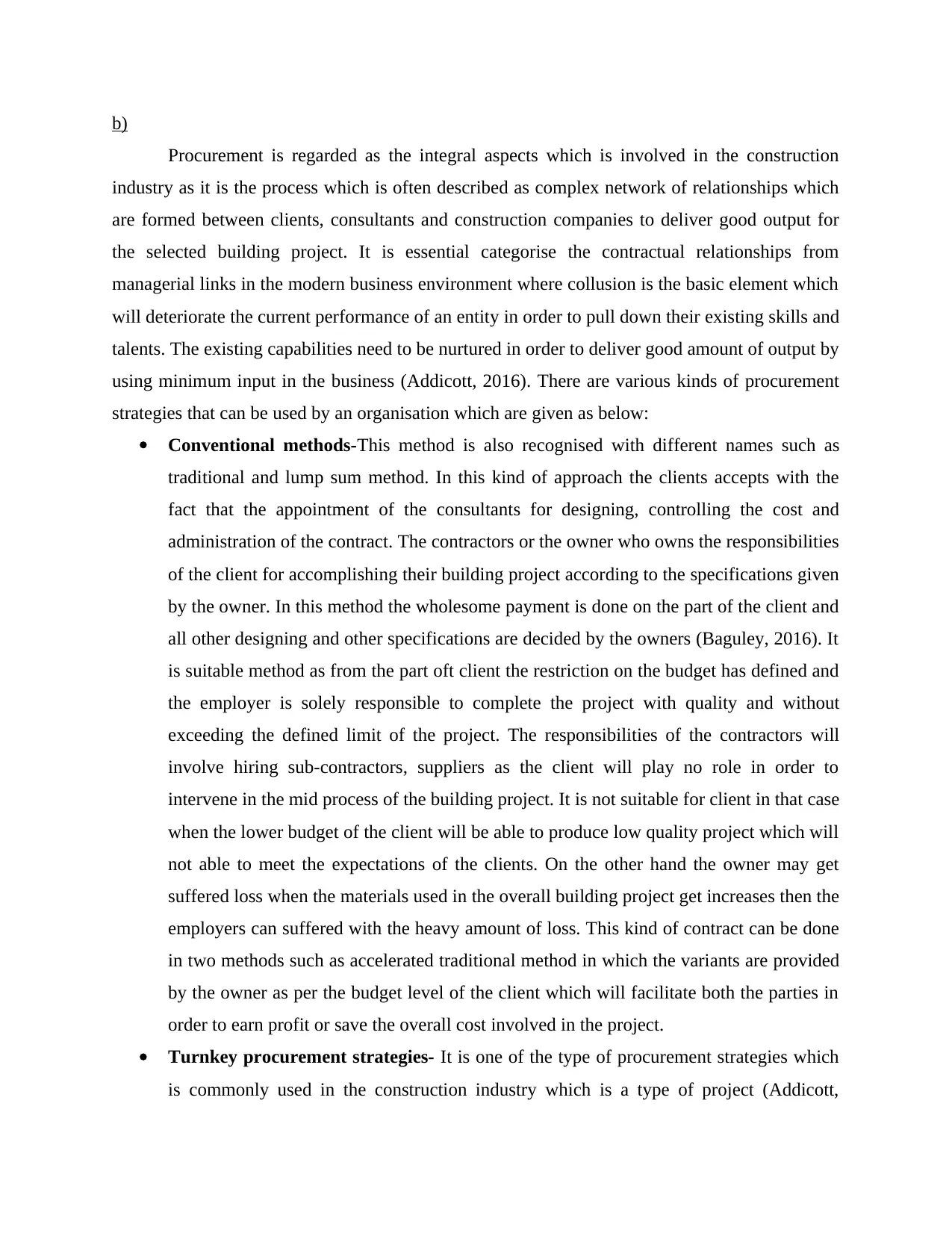
b)
Procurement is regarded as the integral aspects which is involved in the construction
industry as it is the process which is often described as complex network of relationships which
are formed between clients, consultants and construction companies to deliver good output for
the selected building project. It is essential categorise the contractual relationships from
managerial links in the modern business environment where collusion is the basic element which
will deteriorate the current performance of an entity in order to pull down their existing skills and
talents. The existing capabilities need to be nurtured in order to deliver good amount of output by
using minimum input in the business (Addicott, 2016). There are various kinds of procurement
strategies that can be used by an organisation which are given as below:
Conventional methods-This method is also recognised with different names such as
traditional and lump sum method. In this kind of approach the clients accepts with the
fact that the appointment of the consultants for designing, controlling the cost and
administration of the contract. The contractors or the owner who owns the responsibilities
of the client for accomplishing their building project according to the specifications given
by the owner. In this method the wholesome payment is done on the part of the client and
all other designing and other specifications are decided by the owners (Baguley, 2016). It
is suitable method as from the part oft client the restriction on the budget has defined and
the employer is solely responsible to complete the project with quality and without
exceeding the defined limit of the project. The responsibilities of the contractors will
involve hiring sub-contractors, suppliers as the client will play no role in order to
intervene in the mid process of the building project. It is not suitable for client in that case
when the lower budget of the client will be able to produce low quality project which will
not able to meet the expectations of the clients. On the other hand the owner may get
suffered loss when the materials used in the overall building project get increases then the
employers can suffered with the heavy amount of loss. This kind of contract can be done
in two methods such as accelerated traditional method in which the variants are provided
by the owner as per the budget level of the client which will facilitate both the parties in
order to earn profit or save the overall cost involved in the project.
Turnkey procurement strategies- It is one of the type of procurement strategies which
is commonly used in the construction industry which is a type of project (Addicott,
Procurement is regarded as the integral aspects which is involved in the construction
industry as it is the process which is often described as complex network of relationships which
are formed between clients, consultants and construction companies to deliver good output for
the selected building project. It is essential categorise the contractual relationships from
managerial links in the modern business environment where collusion is the basic element which
will deteriorate the current performance of an entity in order to pull down their existing skills and
talents. The existing capabilities need to be nurtured in order to deliver good amount of output by
using minimum input in the business (Addicott, 2016). There are various kinds of procurement
strategies that can be used by an organisation which are given as below:
Conventional methods-This method is also recognised with different names such as
traditional and lump sum method. In this kind of approach the clients accepts with the
fact that the appointment of the consultants for designing, controlling the cost and
administration of the contract. The contractors or the owner who owns the responsibilities
of the client for accomplishing their building project according to the specifications given
by the owner. In this method the wholesome payment is done on the part of the client and
all other designing and other specifications are decided by the owners (Baguley, 2016). It
is suitable method as from the part oft client the restriction on the budget has defined and
the employer is solely responsible to complete the project with quality and without
exceeding the defined limit of the project. The responsibilities of the contractors will
involve hiring sub-contractors, suppliers as the client will play no role in order to
intervene in the mid process of the building project. It is not suitable for client in that case
when the lower budget of the client will be able to produce low quality project which will
not able to meet the expectations of the clients. On the other hand the owner may get
suffered loss when the materials used in the overall building project get increases then the
employers can suffered with the heavy amount of loss. This kind of contract can be done
in two methods such as accelerated traditional method in which the variants are provided
by the owner as per the budget level of the client which will facilitate both the parties in
order to earn profit or save the overall cost involved in the project.
Turnkey procurement strategies- It is one of the type of procurement strategies which
is commonly used in the construction industry which is a type of project (Addicott,
Paraphrase This Document
Need a fresh take? Get an instant paraphrase of this document with our AI Paraphraser
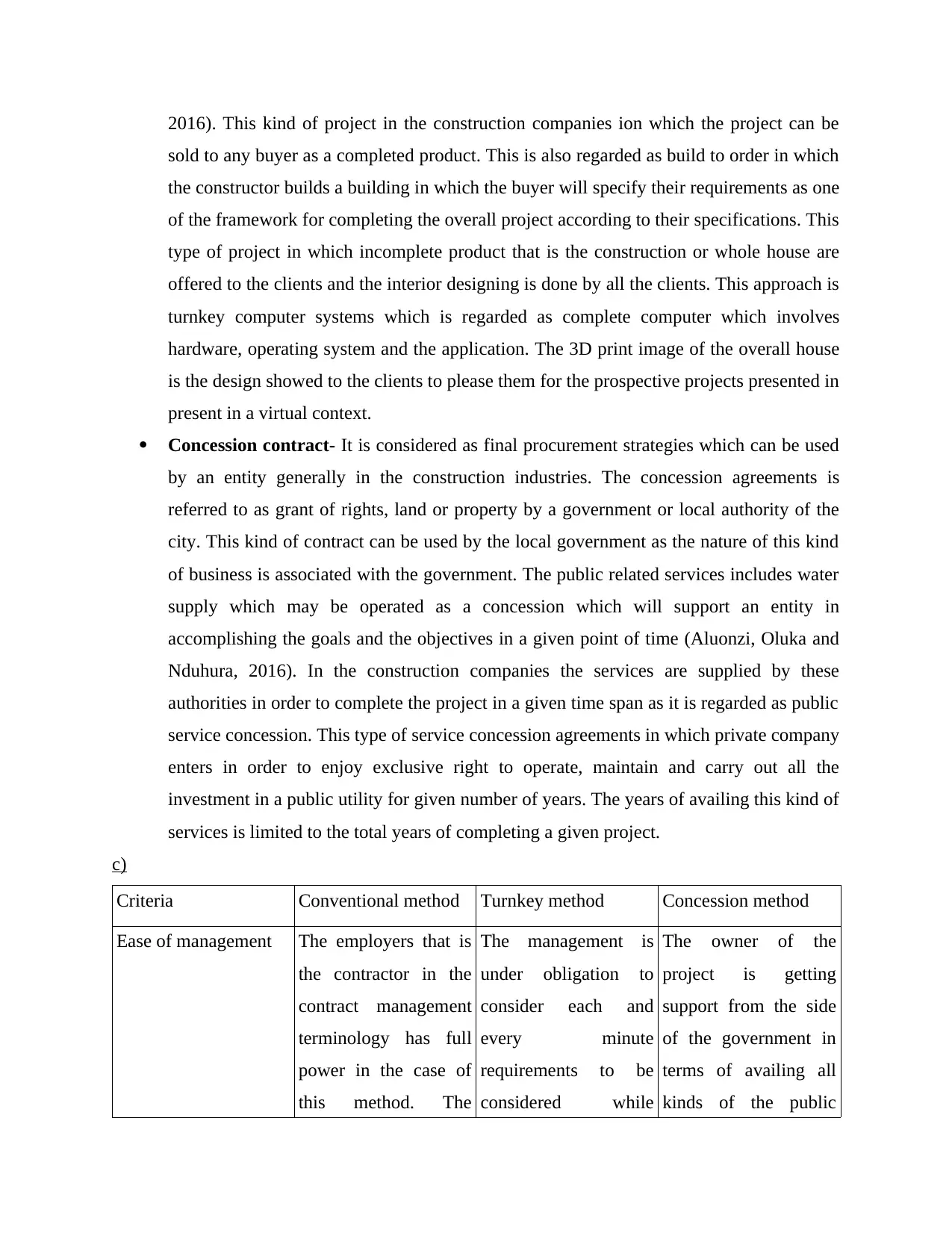
2016). This kind of project in the construction companies ion which the project can be
sold to any buyer as a completed product. This is also regarded as build to order in which
the constructor builds a building in which the buyer will specify their requirements as one
of the framework for completing the overall project according to their specifications. This
type of project in which incomplete product that is the construction or whole house are
offered to the clients and the interior designing is done by all the clients. This approach is
turnkey computer systems which is regarded as complete computer which involves
hardware, operating system and the application. The 3D print image of the overall house
is the design showed to the clients to please them for the prospective projects presented in
present in a virtual context.
Concession contract- It is considered as final procurement strategies which can be used
by an entity generally in the construction industries. The concession agreements is
referred to as grant of rights, land or property by a government or local authority of the
city. This kind of contract can be used by the local government as the nature of this kind
of business is associated with the government. The public related services includes water
supply which may be operated as a concession which will support an entity in
accomplishing the goals and the objectives in a given point of time (Aluonzi, Oluka and
Nduhura, 2016). In the construction companies the services are supplied by these
authorities in order to complete the project in a given time span as it is regarded as public
service concession. This type of service concession agreements in which private company
enters in order to enjoy exclusive right to operate, maintain and carry out all the
investment in a public utility for given number of years. The years of availing this kind of
services is limited to the total years of completing a given project.
c)
Criteria Conventional method Turnkey method Concession method
Ease of management The employers that is
the contractor in the
contract management
terminology has full
power in the case of
this method. The
The management is
under obligation to
consider each and
every minute
requirements to be
considered while
The owner of the
project is getting
support from the side
of the government in
terms of availing all
kinds of the public
sold to any buyer as a completed product. This is also regarded as build to order in which
the constructor builds a building in which the buyer will specify their requirements as one
of the framework for completing the overall project according to their specifications. This
type of project in which incomplete product that is the construction or whole house are
offered to the clients and the interior designing is done by all the clients. This approach is
turnkey computer systems which is regarded as complete computer which involves
hardware, operating system and the application. The 3D print image of the overall house
is the design showed to the clients to please them for the prospective projects presented in
present in a virtual context.
Concession contract- It is considered as final procurement strategies which can be used
by an entity generally in the construction industries. The concession agreements is
referred to as grant of rights, land or property by a government or local authority of the
city. This kind of contract can be used by the local government as the nature of this kind
of business is associated with the government. The public related services includes water
supply which may be operated as a concession which will support an entity in
accomplishing the goals and the objectives in a given point of time (Aluonzi, Oluka and
Nduhura, 2016). In the construction companies the services are supplied by these
authorities in order to complete the project in a given time span as it is regarded as public
service concession. This type of service concession agreements in which private company
enters in order to enjoy exclusive right to operate, maintain and carry out all the
investment in a public utility for given number of years. The years of availing this kind of
services is limited to the total years of completing a given project.
c)
Criteria Conventional method Turnkey method Concession method
Ease of management The employers that is
the contractor in the
contract management
terminology has full
power in the case of
this method. The
The management is
under obligation to
consider each and
every minute
requirements to be
considered while
The owner of the
project is getting
support from the side
of the government in
terms of availing all
kinds of the public
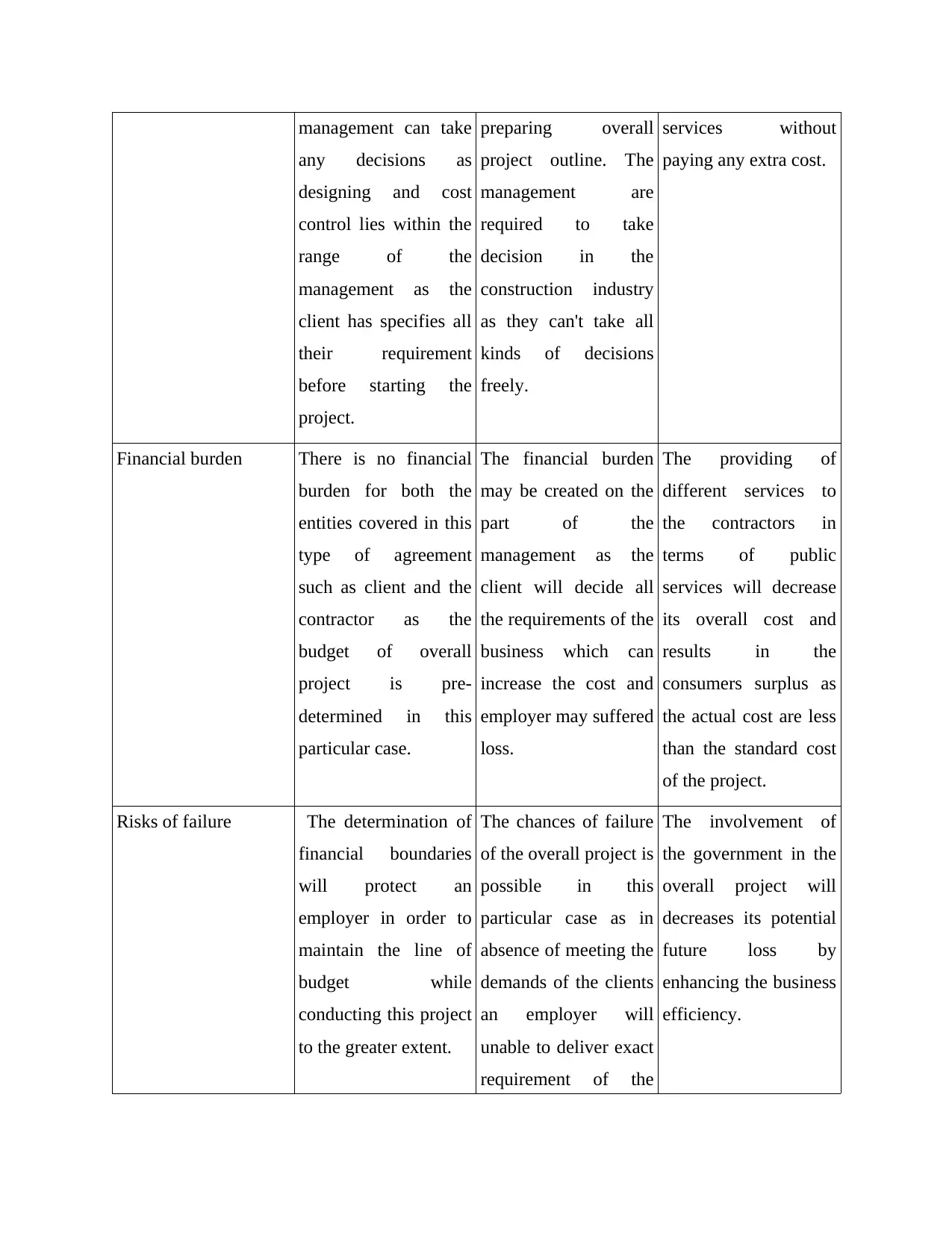
management can take
any decisions as
designing and cost
control lies within the
range of the
management as the
client has specifies all
their requirement
before starting the
project.
preparing overall
project outline. The
management are
required to take
decision in the
construction industry
as they can't take all
kinds of decisions
freely.
services without
paying any extra cost.
Financial burden There is no financial
burden for both the
entities covered in this
type of agreement
such as client and the
contractor as the
budget of overall
project is pre-
determined in this
particular case.
The financial burden
may be created on the
part of the
management as the
client will decide all
the requirements of the
business which can
increase the cost and
employer may suffered
loss.
The providing of
different services to
the contractors in
terms of public
services will decrease
its overall cost and
results in the
consumers surplus as
the actual cost are less
than the standard cost
of the project.
Risks of failure The determination of
financial boundaries
will protect an
employer in order to
maintain the line of
budget while
conducting this project
to the greater extent.
The chances of failure
of the overall project is
possible in this
particular case as in
absence of meeting the
demands of the clients
an employer will
unable to deliver exact
requirement of the
The involvement of
the government in the
overall project will
decreases its potential
future loss by
enhancing the business
efficiency.
any decisions as
designing and cost
control lies within the
range of the
management as the
client has specifies all
their requirement
before starting the
project.
preparing overall
project outline. The
management are
required to take
decision in the
construction industry
as they can't take all
kinds of decisions
freely.
services without
paying any extra cost.
Financial burden There is no financial
burden for both the
entities covered in this
type of agreement
such as client and the
contractor as the
budget of overall
project is pre-
determined in this
particular case.
The financial burden
may be created on the
part of the
management as the
client will decide all
the requirements of the
business which can
increase the cost and
employer may suffered
loss.
The providing of
different services to
the contractors in
terms of public
services will decrease
its overall cost and
results in the
consumers surplus as
the actual cost are less
than the standard cost
of the project.
Risks of failure The determination of
financial boundaries
will protect an
employer in order to
maintain the line of
budget while
conducting this project
to the greater extent.
The chances of failure
of the overall project is
possible in this
particular case as in
absence of meeting the
demands of the clients
an employer will
unable to deliver exact
requirement of the
The involvement of
the government in the
overall project will
decreases its potential
future loss by
enhancing the business
efficiency.
⊘ This is a preview!⊘
Do you want full access?
Subscribe today to unlock all pages.

Trusted by 1+ million students worldwide
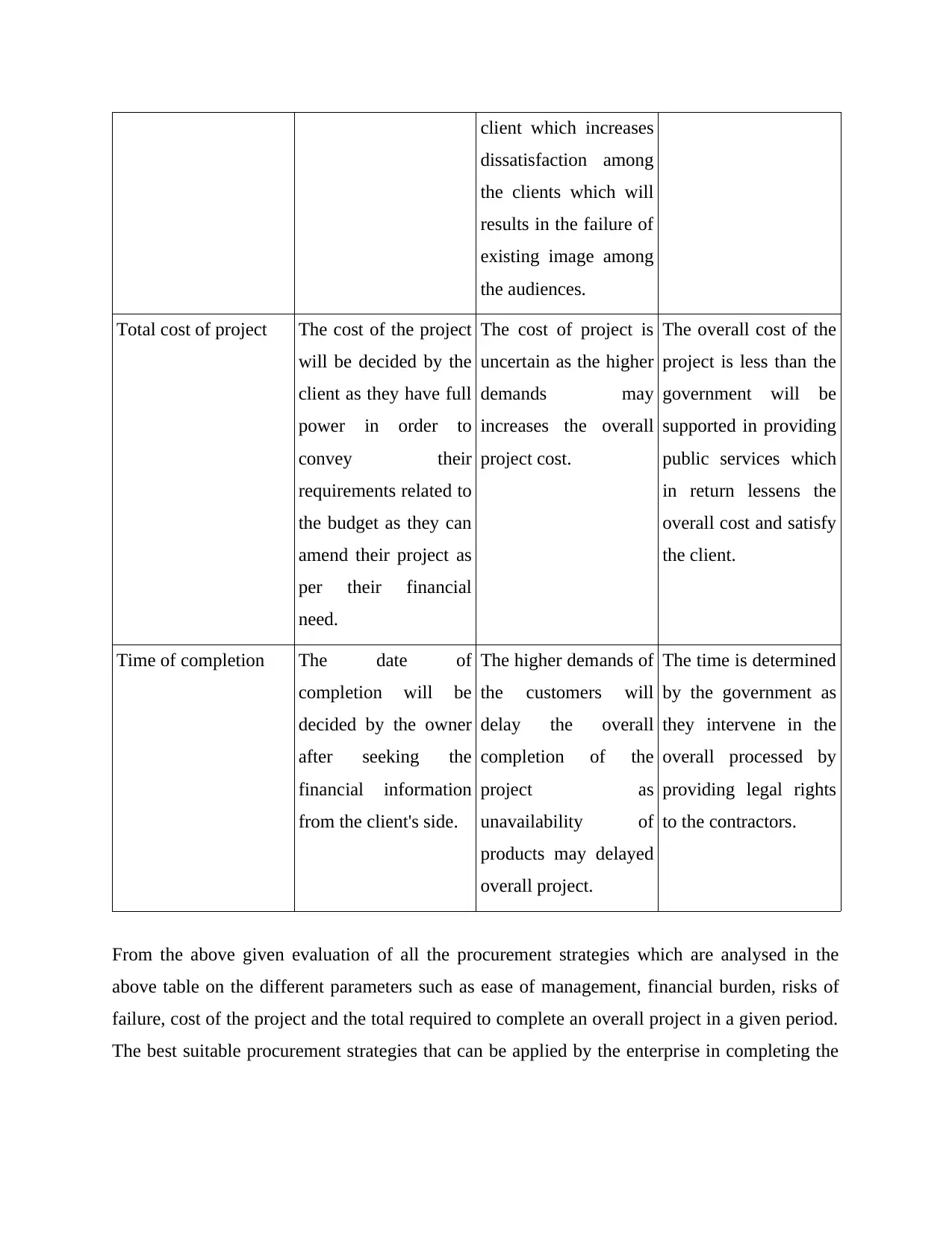
client which increases
dissatisfaction among
the clients which will
results in the failure of
existing image among
the audiences.
Total cost of project The cost of the project
will be decided by the
client as they have full
power in order to
convey their
requirements related to
the budget as they can
amend their project as
per their financial
need.
The cost of project is
uncertain as the higher
demands may
increases the overall
project cost.
The overall cost of the
project is less than the
government will be
supported in providing
public services which
in return lessens the
overall cost and satisfy
the client.
Time of completion The date of
completion will be
decided by the owner
after seeking the
financial information
from the client's side.
The higher demands of
the customers will
delay the overall
completion of the
project as
unavailability of
products may delayed
overall project.
The time is determined
by the government as
they intervene in the
overall processed by
providing legal rights
to the contractors.
From the above given evaluation of all the procurement strategies which are analysed in the
above table on the different parameters such as ease of management, financial burden, risks of
failure, cost of the project and the total required to complete an overall project in a given period.
The best suitable procurement strategies that can be applied by the enterprise in completing the
dissatisfaction among
the clients which will
results in the failure of
existing image among
the audiences.
Total cost of project The cost of the project
will be decided by the
client as they have full
power in order to
convey their
requirements related to
the budget as they can
amend their project as
per their financial
need.
The cost of project is
uncertain as the higher
demands may
increases the overall
project cost.
The overall cost of the
project is less than the
government will be
supported in providing
public services which
in return lessens the
overall cost and satisfy
the client.
Time of completion The date of
completion will be
decided by the owner
after seeking the
financial information
from the client's side.
The higher demands of
the customers will
delay the overall
completion of the
project as
unavailability of
products may delayed
overall project.
The time is determined
by the government as
they intervene in the
overall processed by
providing legal rights
to the contractors.
From the above given evaluation of all the procurement strategies which are analysed in the
above table on the different parameters such as ease of management, financial burden, risks of
failure, cost of the project and the total required to complete an overall project in a given period.
The best suitable procurement strategies that can be applied by the enterprise in completing the
Paraphrase This Document
Need a fresh take? Get an instant paraphrase of this document with our AI Paraphraser
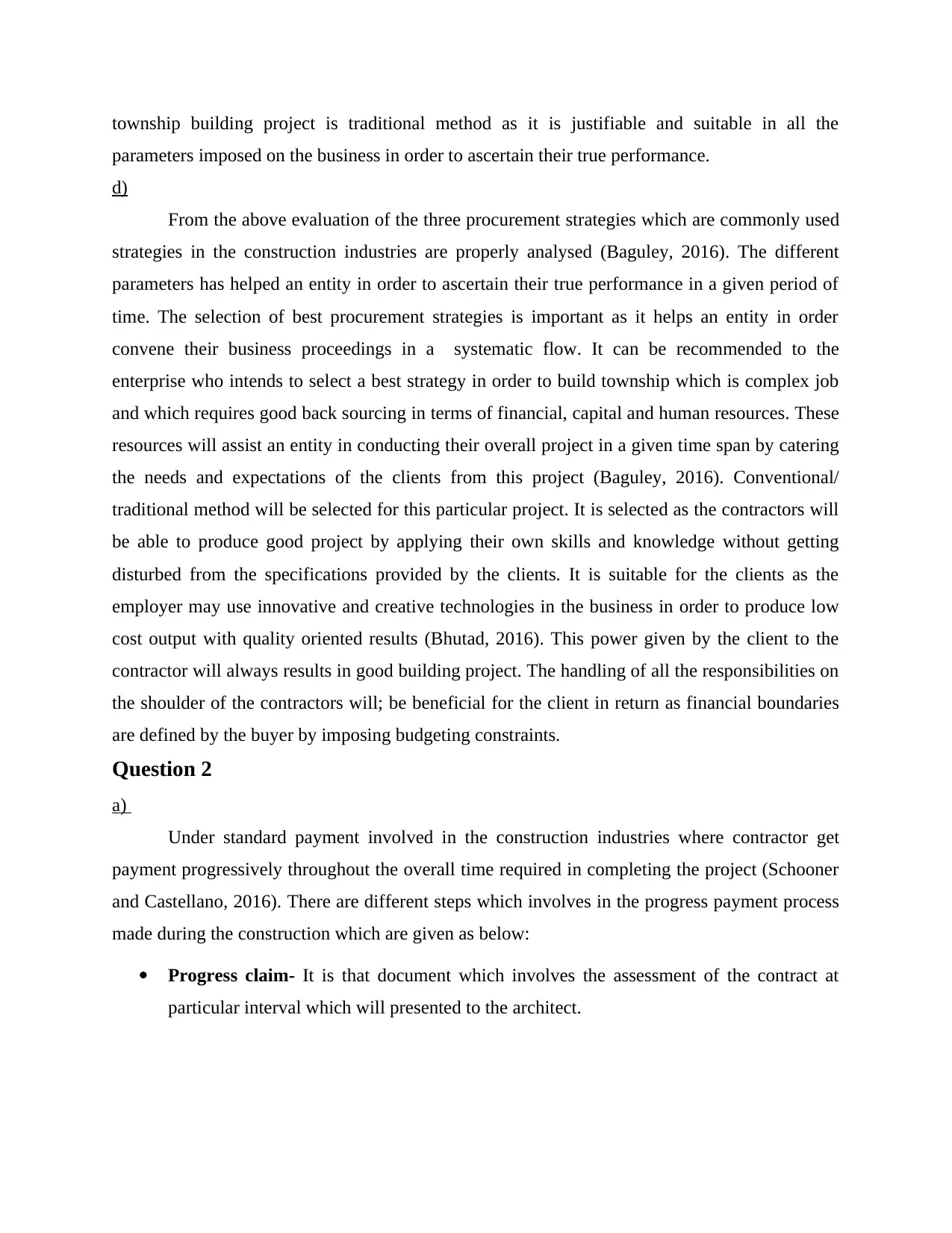
township building project is traditional method as it is justifiable and suitable in all the
parameters imposed on the business in order to ascertain their true performance.
d)
From the above evaluation of the three procurement strategies which are commonly used
strategies in the construction industries are properly analysed (Baguley, 2016). The different
parameters has helped an entity in order to ascertain their true performance in a given period of
time. The selection of best procurement strategies is important as it helps an entity in order
convene their business proceedings in a systematic flow. It can be recommended to the
enterprise who intends to select a best strategy in order to build township which is complex job
and which requires good back sourcing in terms of financial, capital and human resources. These
resources will assist an entity in conducting their overall project in a given time span by catering
the needs and expectations of the clients from this project (Baguley, 2016). Conventional/
traditional method will be selected for this particular project. It is selected as the contractors will
be able to produce good project by applying their own skills and knowledge without getting
disturbed from the specifications provided by the clients. It is suitable for the clients as the
employer may use innovative and creative technologies in the business in order to produce low
cost output with quality oriented results (Bhutad, 2016). This power given by the client to the
contractor will always results in good building project. The handling of all the responsibilities on
the shoulder of the contractors will; be beneficial for the client in return as financial boundaries
are defined by the buyer by imposing budgeting constraints.
Question 2
a)
Under standard payment involved in the construction industries where contractor get
payment progressively throughout the overall time required in completing the project (Schooner
and Castellano, 2016). There are different steps which involves in the progress payment process
made during the construction which are given as below:
Progress claim- It is that document which involves the assessment of the contract at
particular interval which will presented to the architect.
parameters imposed on the business in order to ascertain their true performance.
d)
From the above evaluation of the three procurement strategies which are commonly used
strategies in the construction industries are properly analysed (Baguley, 2016). The different
parameters has helped an entity in order to ascertain their true performance in a given period of
time. The selection of best procurement strategies is important as it helps an entity in order
convene their business proceedings in a systematic flow. It can be recommended to the
enterprise who intends to select a best strategy in order to build township which is complex job
and which requires good back sourcing in terms of financial, capital and human resources. These
resources will assist an entity in conducting their overall project in a given time span by catering
the needs and expectations of the clients from this project (Baguley, 2016). Conventional/
traditional method will be selected for this particular project. It is selected as the contractors will
be able to produce good project by applying their own skills and knowledge without getting
disturbed from the specifications provided by the clients. It is suitable for the clients as the
employer may use innovative and creative technologies in the business in order to produce low
cost output with quality oriented results (Bhutad, 2016). This power given by the client to the
contractor will always results in good building project. The handling of all the responsibilities on
the shoulder of the contractors will; be beneficial for the client in return as financial boundaries
are defined by the buyer by imposing budgeting constraints.
Question 2
a)
Under standard payment involved in the construction industries where contractor get
payment progressively throughout the overall time required in completing the project (Schooner
and Castellano, 2016). There are different steps which involves in the progress payment process
made during the construction which are given as below:
Progress claim- It is that document which involves the assessment of the contract at
particular interval which will presented to the architect.
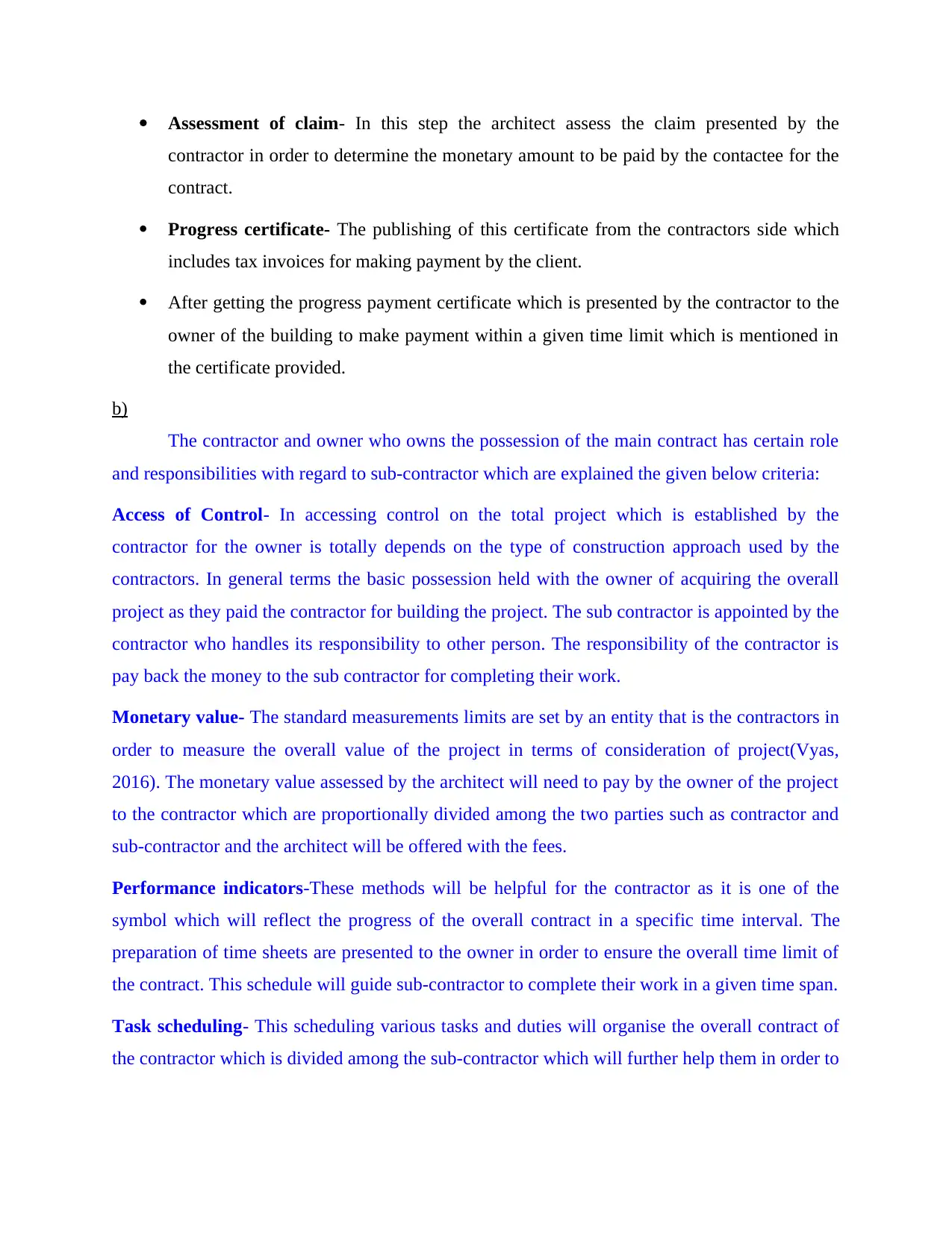
Assessment of claim- In this step the architect assess the claim presented by the
contractor in order to determine the monetary amount to be paid by the contactee for the
contract.
Progress certificate- The publishing of this certificate from the contractors side which
includes tax invoices for making payment by the client.
After getting the progress payment certificate which is presented by the contractor to the
owner of the building to make payment within a given time limit which is mentioned in
the certificate provided.
b)
The contractor and owner who owns the possession of the main contract has certain role
and responsibilities with regard to sub-contractor which are explained the given below criteria:
Access of Control- In accessing control on the total project which is established by the
contractor for the owner is totally depends on the type of construction approach used by the
contractors. In general terms the basic possession held with the owner of acquiring the overall
project as they paid the contractor for building the project. The sub contractor is appointed by the
contractor who handles its responsibility to other person. The responsibility of the contractor is
pay back the money to the sub contractor for completing their work.
Monetary value- The standard measurements limits are set by an entity that is the contractors in
order to measure the overall value of the project in terms of consideration of project(Vyas,
2016). The monetary value assessed by the architect will need to pay by the owner of the project
to the contractor which are proportionally divided among the two parties such as contractor and
sub-contractor and the architect will be offered with the fees.
Performance indicators-These methods will be helpful for the contractor as it is one of the
symbol which will reflect the progress of the overall contract in a specific time interval. The
preparation of time sheets are presented to the owner in order to ensure the overall time limit of
the contract. This schedule will guide sub-contractor to complete their work in a given time span.
Task scheduling- This scheduling various tasks and duties will organise the overall contract of
the contractor which is divided among the sub-contractor which will further help them in order to
contractor in order to determine the monetary amount to be paid by the contactee for the
contract.
Progress certificate- The publishing of this certificate from the contractors side which
includes tax invoices for making payment by the client.
After getting the progress payment certificate which is presented by the contractor to the
owner of the building to make payment within a given time limit which is mentioned in
the certificate provided.
b)
The contractor and owner who owns the possession of the main contract has certain role
and responsibilities with regard to sub-contractor which are explained the given below criteria:
Access of Control- In accessing control on the total project which is established by the
contractor for the owner is totally depends on the type of construction approach used by the
contractors. In general terms the basic possession held with the owner of acquiring the overall
project as they paid the contractor for building the project. The sub contractor is appointed by the
contractor who handles its responsibility to other person. The responsibility of the contractor is
pay back the money to the sub contractor for completing their work.
Monetary value- The standard measurements limits are set by an entity that is the contractors in
order to measure the overall value of the project in terms of consideration of project(Vyas,
2016). The monetary value assessed by the architect will need to pay by the owner of the project
to the contractor which are proportionally divided among the two parties such as contractor and
sub-contractor and the architect will be offered with the fees.
Performance indicators-These methods will be helpful for the contractor as it is one of the
symbol which will reflect the progress of the overall contract in a specific time interval. The
preparation of time sheets are presented to the owner in order to ensure the overall time limit of
the contract. This schedule will guide sub-contractor to complete their work in a given time span.
Task scheduling- This scheduling various tasks and duties will organise the overall contract of
the contractor which is divided among the sub-contractor which will further help them in order to
⊘ This is a preview!⊘
Do you want full access?
Subscribe today to unlock all pages.

Trusted by 1+ million students worldwide
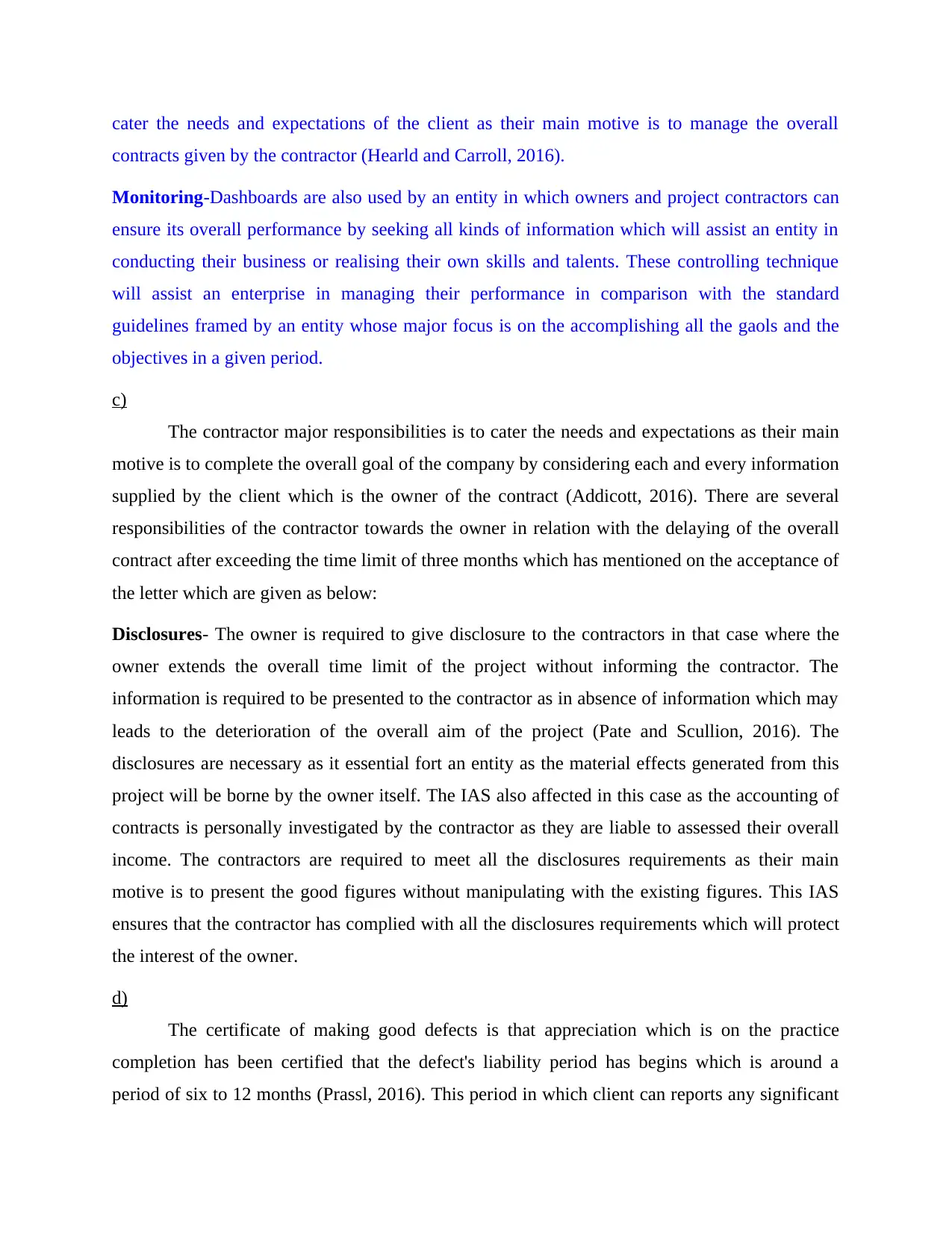
cater the needs and expectations of the client as their main motive is to manage the overall
contracts given by the contractor (Hearld and Carroll, 2016).
Monitoring-Dashboards are also used by an entity in which owners and project contractors can
ensure its overall performance by seeking all kinds of information which will assist an entity in
conducting their business or realising their own skills and talents. These controlling technique
will assist an enterprise in managing their performance in comparison with the standard
guidelines framed by an entity whose major focus is on the accomplishing all the gaols and the
objectives in a given period.
c)
The contractor major responsibilities is to cater the needs and expectations as their main
motive is to complete the overall goal of the company by considering each and every information
supplied by the client which is the owner of the contract (Addicott, 2016). There are several
responsibilities of the contractor towards the owner in relation with the delaying of the overall
contract after exceeding the time limit of three months which has mentioned on the acceptance of
the letter which are given as below:
Disclosures- The owner is required to give disclosure to the contractors in that case where the
owner extends the overall time limit of the project without informing the contractor. The
information is required to be presented to the contractor as in absence of information which may
leads to the deterioration of the overall aim of the project (Pate and Scullion, 2016). The
disclosures are necessary as it essential fort an entity as the material effects generated from this
project will be borne by the owner itself. The IAS also affected in this case as the accounting of
contracts is personally investigated by the contractor as they are liable to assessed their overall
income. The contractors are required to meet all the disclosures requirements as their main
motive is to present the good figures without manipulating with the existing figures. This IAS
ensures that the contractor has complied with all the disclosures requirements which will protect
the interest of the owner.
d)
The certificate of making good defects is that appreciation which is on the practice
completion has been certified that the defect's liability period has begins which is around a
period of six to 12 months (Prassl, 2016). This period in which client can reports any significant
contracts given by the contractor (Hearld and Carroll, 2016).
Monitoring-Dashboards are also used by an entity in which owners and project contractors can
ensure its overall performance by seeking all kinds of information which will assist an entity in
conducting their business or realising their own skills and talents. These controlling technique
will assist an enterprise in managing their performance in comparison with the standard
guidelines framed by an entity whose major focus is on the accomplishing all the gaols and the
objectives in a given period.
c)
The contractor major responsibilities is to cater the needs and expectations as their main
motive is to complete the overall goal of the company by considering each and every information
supplied by the client which is the owner of the contract (Addicott, 2016). There are several
responsibilities of the contractor towards the owner in relation with the delaying of the overall
contract after exceeding the time limit of three months which has mentioned on the acceptance of
the letter which are given as below:
Disclosures- The owner is required to give disclosure to the contractors in that case where the
owner extends the overall time limit of the project without informing the contractor. The
information is required to be presented to the contractor as in absence of information which may
leads to the deterioration of the overall aim of the project (Pate and Scullion, 2016). The
disclosures are necessary as it essential fort an entity as the material effects generated from this
project will be borne by the owner itself. The IAS also affected in this case as the accounting of
contracts is personally investigated by the contractor as they are liable to assessed their overall
income. The contractors are required to meet all the disclosures requirements as their main
motive is to present the good figures without manipulating with the existing figures. This IAS
ensures that the contractor has complied with all the disclosures requirements which will protect
the interest of the owner.
d)
The certificate of making good defects is that appreciation which is on the practice
completion has been certified that the defect's liability period has begins which is around a
period of six to 12 months (Prassl, 2016). This period in which client can reports any significant
Paraphrase This Document
Need a fresh take? Get an instant paraphrase of this document with our AI Paraphraser
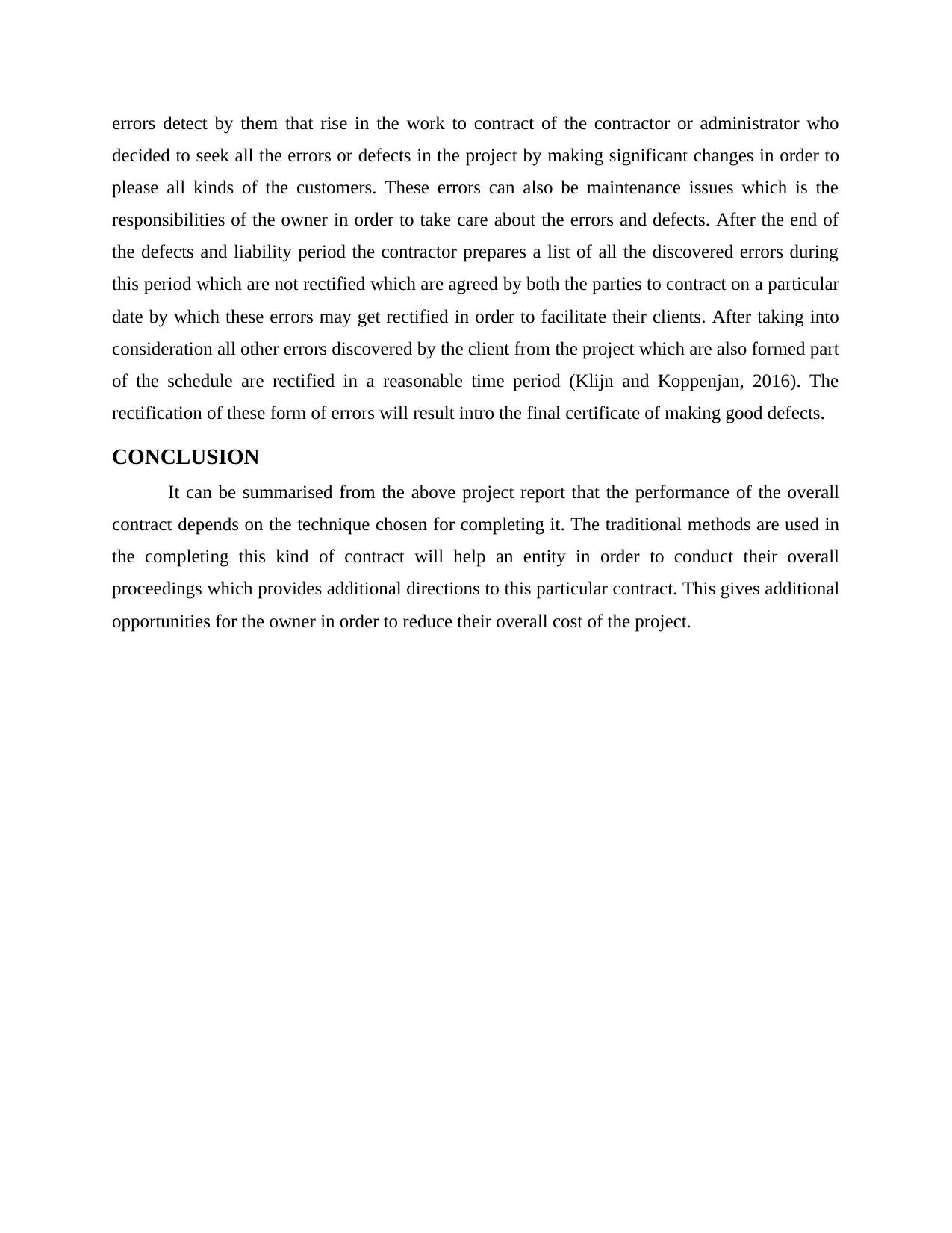
errors detect by them that rise in the work to contract of the contractor or administrator who
decided to seek all the errors or defects in the project by making significant changes in order to
please all kinds of the customers. These errors can also be maintenance issues which is the
responsibilities of the owner in order to take care about the errors and defects. After the end of
the defects and liability period the contractor prepares a list of all the discovered errors during
this period which are not rectified which are agreed by both the parties to contract on a particular
date by which these errors may get rectified in order to facilitate their clients. After taking into
consideration all other errors discovered by the client from the project which are also formed part
of the schedule are rectified in a reasonable time period (Klijn and Koppenjan, 2016). The
rectification of these form of errors will result intro the final certificate of making good defects.
CONCLUSION
It can be summarised from the above project report that the performance of the overall
contract depends on the technique chosen for completing it. The traditional methods are used in
the completing this kind of contract will help an entity in order to conduct their overall
proceedings which provides additional directions to this particular contract. This gives additional
opportunities for the owner in order to reduce their overall cost of the project.
decided to seek all the errors or defects in the project by making significant changes in order to
please all kinds of the customers. These errors can also be maintenance issues which is the
responsibilities of the owner in order to take care about the errors and defects. After the end of
the defects and liability period the contractor prepares a list of all the discovered errors during
this period which are not rectified which are agreed by both the parties to contract on a particular
date by which these errors may get rectified in order to facilitate their clients. After taking into
consideration all other errors discovered by the client from the project which are also formed part
of the schedule are rectified in a reasonable time period (Klijn and Koppenjan, 2016). The
rectification of these form of errors will result intro the final certificate of making good defects.
CONCLUSION
It can be summarised from the above project report that the performance of the overall
contract depends on the technique chosen for completing it. The traditional methods are used in
the completing this kind of contract will help an entity in order to conduct their overall
proceedings which provides additional directions to this particular contract. This gives additional
opportunities for the owner in order to reduce their overall cost of the project.
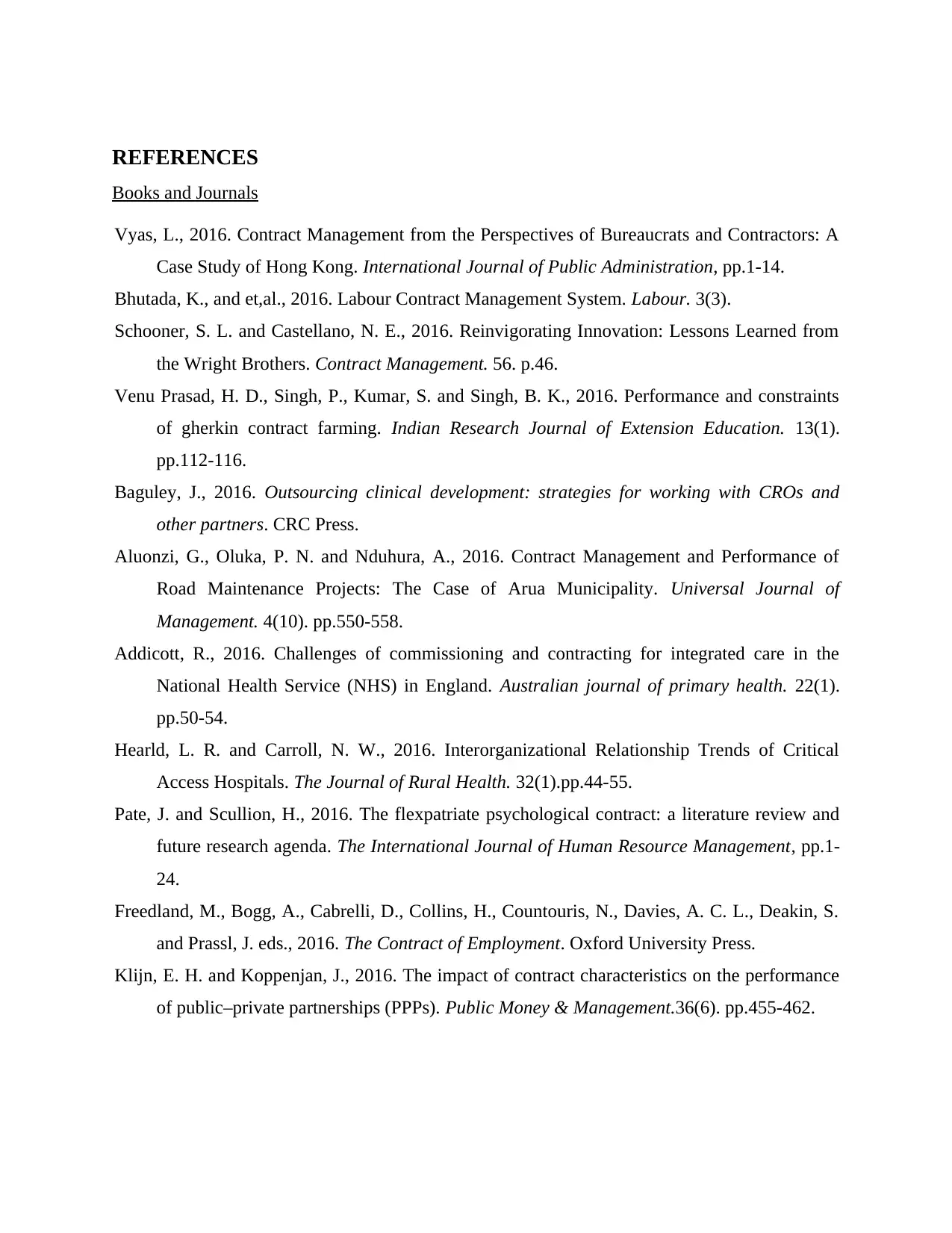
REFERENCES
Books and Journals
Vyas, L., 2016. Contract Management from the Perspectives of Bureaucrats and Contractors: A
Case Study of Hong Kong. International Journal of Public Administration, pp.1-14.
Bhutada, K., and et,al., 2016. Labour Contract Management System. Labour. 3(3).
Schooner, S. L. and Castellano, N. E., 2016. Reinvigorating Innovation: Lessons Learned from
the Wright Brothers. Contract Management. 56. p.46.
Venu Prasad, H. D., Singh, P., Kumar, S. and Singh, B. K., 2016. Performance and constraints
of gherkin contract farming. Indian Research Journal of Extension Education. 13(1).
pp.112-116.
Baguley, J., 2016. Outsourcing clinical development: strategies for working with CROs and
other partners. CRC Press.
Aluonzi, G., Oluka, P. N. and Nduhura, A., 2016. Contract Management and Performance of
Road Maintenance Projects: The Case of Arua Municipality. Universal Journal of
Management. 4(10). pp.550-558.
Addicott, R., 2016. Challenges of commissioning and contracting for integrated care in the
National Health Service (NHS) in England. Australian journal of primary health. 22(1).
pp.50-54.
Hearld, L. R. and Carroll, N. W., 2016. Interorganizational Relationship Trends of Critical
Access Hospitals. The Journal of Rural Health. 32(1).pp.44-55.
Pate, J. and Scullion, H., 2016. The flexpatriate psychological contract: a literature review and
future research agenda. The International Journal of Human Resource Management, pp.1-
24.
Freedland, M., Bogg, A., Cabrelli, D., Collins, H., Countouris, N., Davies, A. C. L., Deakin, S.
and Prassl, J. eds., 2016. The Contract of Employment. Oxford University Press.
Klijn, E. H. and Koppenjan, J., 2016. The impact of contract characteristics on the performance
of public–private partnerships (PPPs). Public Money & Management.36(6). pp.455-462.
Books and Journals
Vyas, L., 2016. Contract Management from the Perspectives of Bureaucrats and Contractors: A
Case Study of Hong Kong. International Journal of Public Administration, pp.1-14.
Bhutada, K., and et,al., 2016. Labour Contract Management System. Labour. 3(3).
Schooner, S. L. and Castellano, N. E., 2016. Reinvigorating Innovation: Lessons Learned from
the Wright Brothers. Contract Management. 56. p.46.
Venu Prasad, H. D., Singh, P., Kumar, S. and Singh, B. K., 2016. Performance and constraints
of gherkin contract farming. Indian Research Journal of Extension Education. 13(1).
pp.112-116.
Baguley, J., 2016. Outsourcing clinical development: strategies for working with CROs and
other partners. CRC Press.
Aluonzi, G., Oluka, P. N. and Nduhura, A., 2016. Contract Management and Performance of
Road Maintenance Projects: The Case of Arua Municipality. Universal Journal of
Management. 4(10). pp.550-558.
Addicott, R., 2016. Challenges of commissioning and contracting for integrated care in the
National Health Service (NHS) in England. Australian journal of primary health. 22(1).
pp.50-54.
Hearld, L. R. and Carroll, N. W., 2016. Interorganizational Relationship Trends of Critical
Access Hospitals. The Journal of Rural Health. 32(1).pp.44-55.
Pate, J. and Scullion, H., 2016. The flexpatriate psychological contract: a literature review and
future research agenda. The International Journal of Human Resource Management, pp.1-
24.
Freedland, M., Bogg, A., Cabrelli, D., Collins, H., Countouris, N., Davies, A. C. L., Deakin, S.
and Prassl, J. eds., 2016. The Contract of Employment. Oxford University Press.
Klijn, E. H. and Koppenjan, J., 2016. The impact of contract characteristics on the performance
of public–private partnerships (PPPs). Public Money & Management.36(6). pp.455-462.
⊘ This is a preview!⊘
Do you want full access?
Subscribe today to unlock all pages.

Trusted by 1+ million students worldwide
1 out of 13
Related Documents
Your All-in-One AI-Powered Toolkit for Academic Success.
+13062052269
info@desklib.com
Available 24*7 on WhatsApp / Email
![[object Object]](/_next/static/media/star-bottom.7253800d.svg)
Unlock your academic potential
Copyright © 2020–2025 A2Z Services. All Rights Reserved. Developed and managed by ZUCOL.




